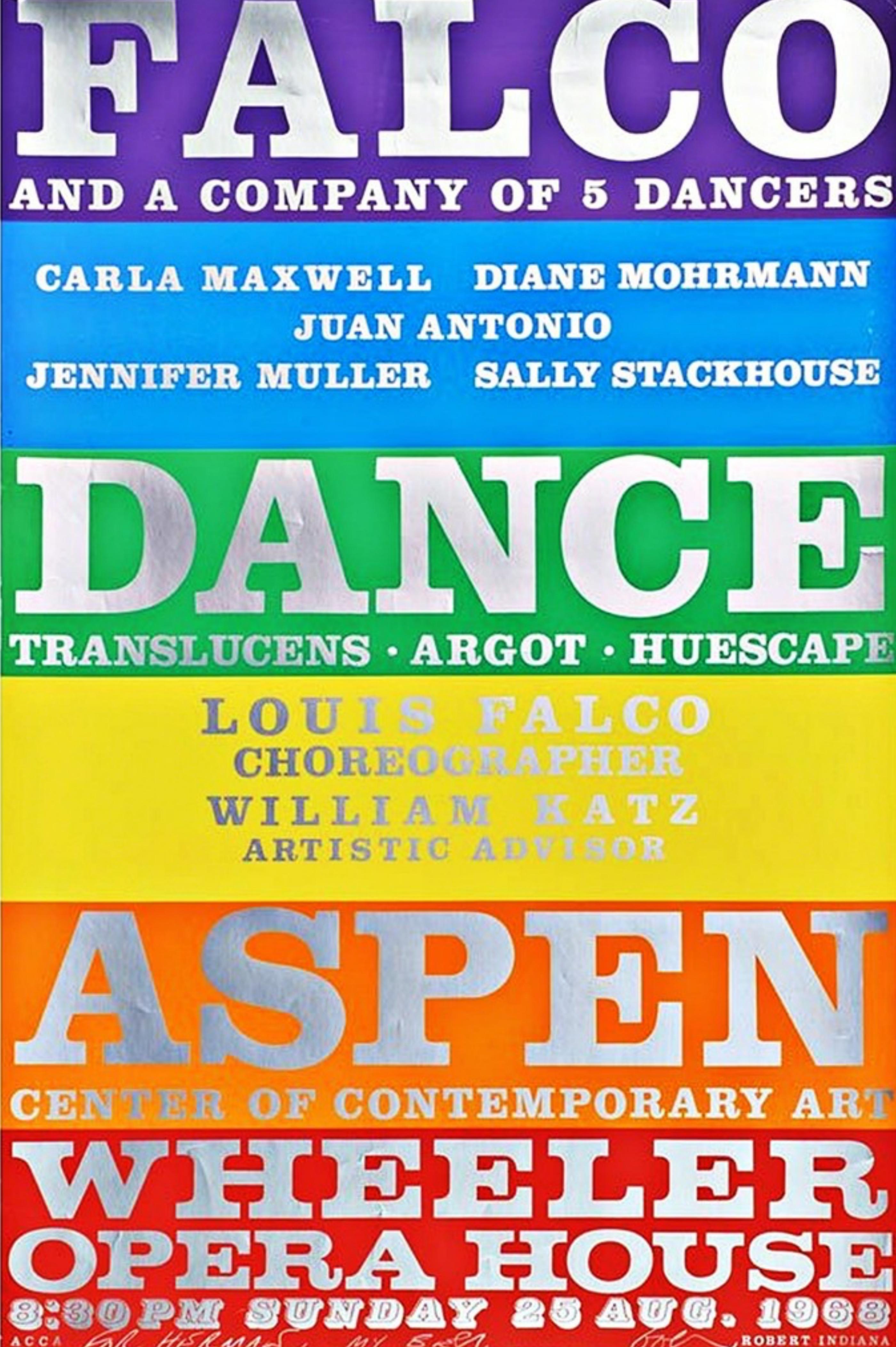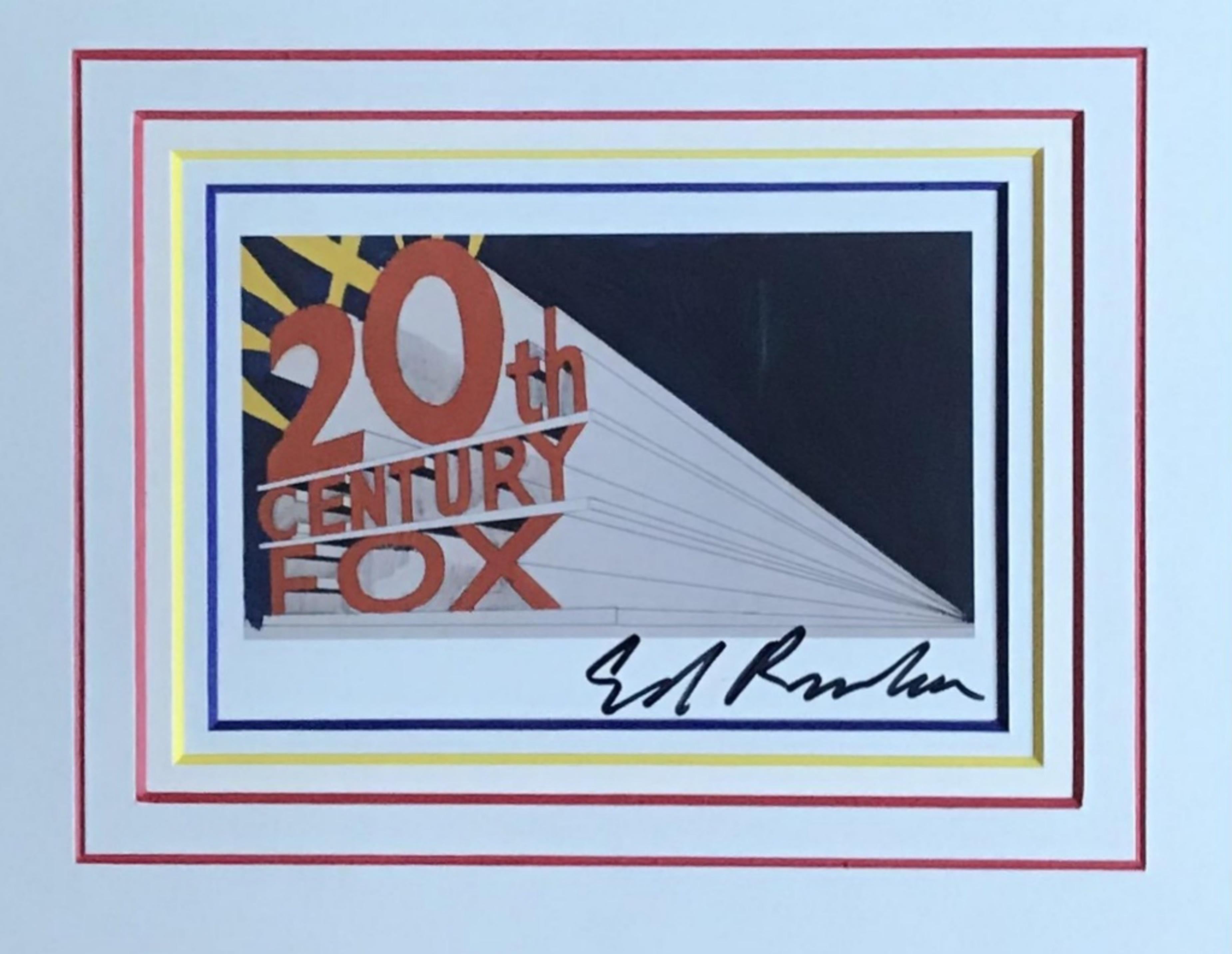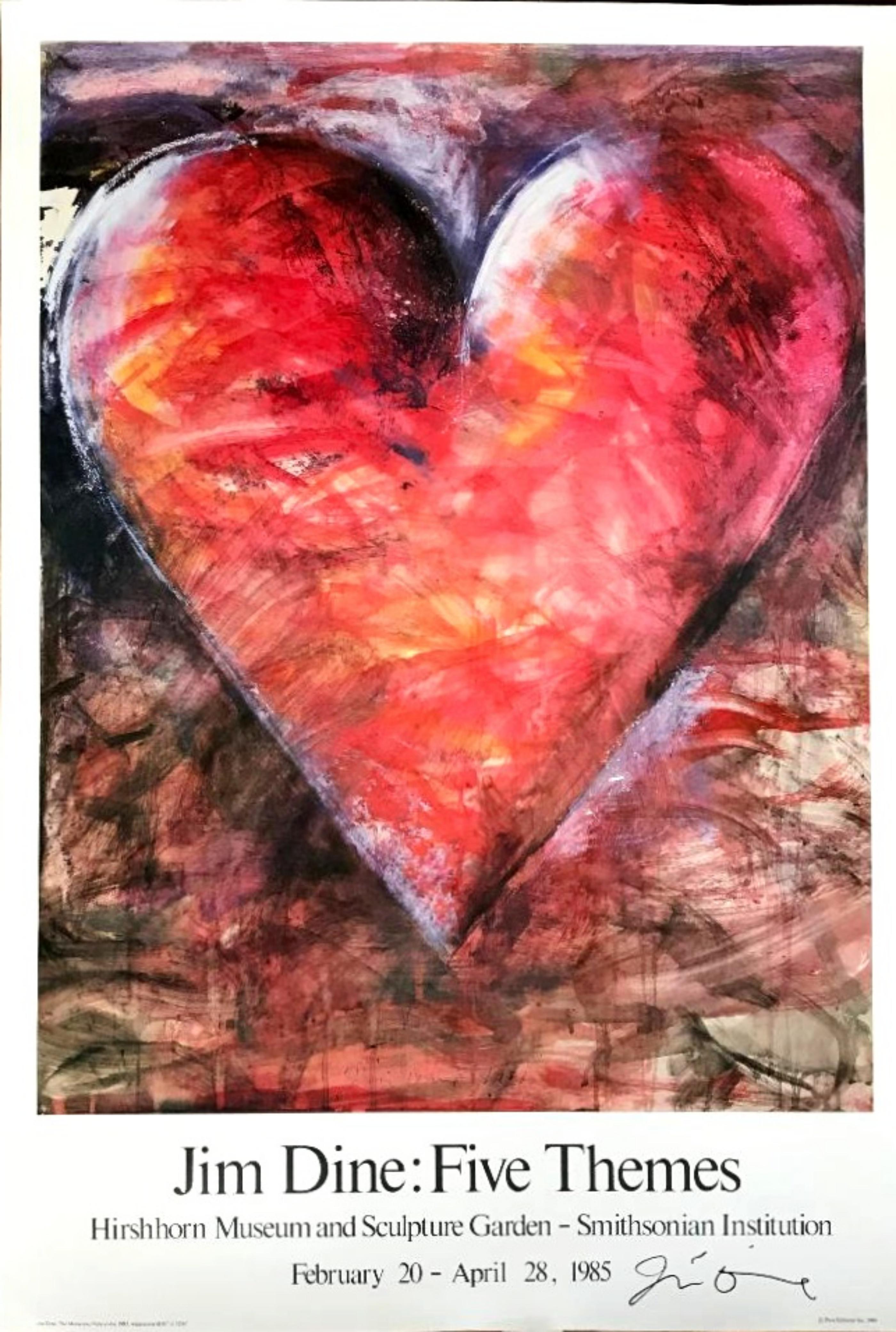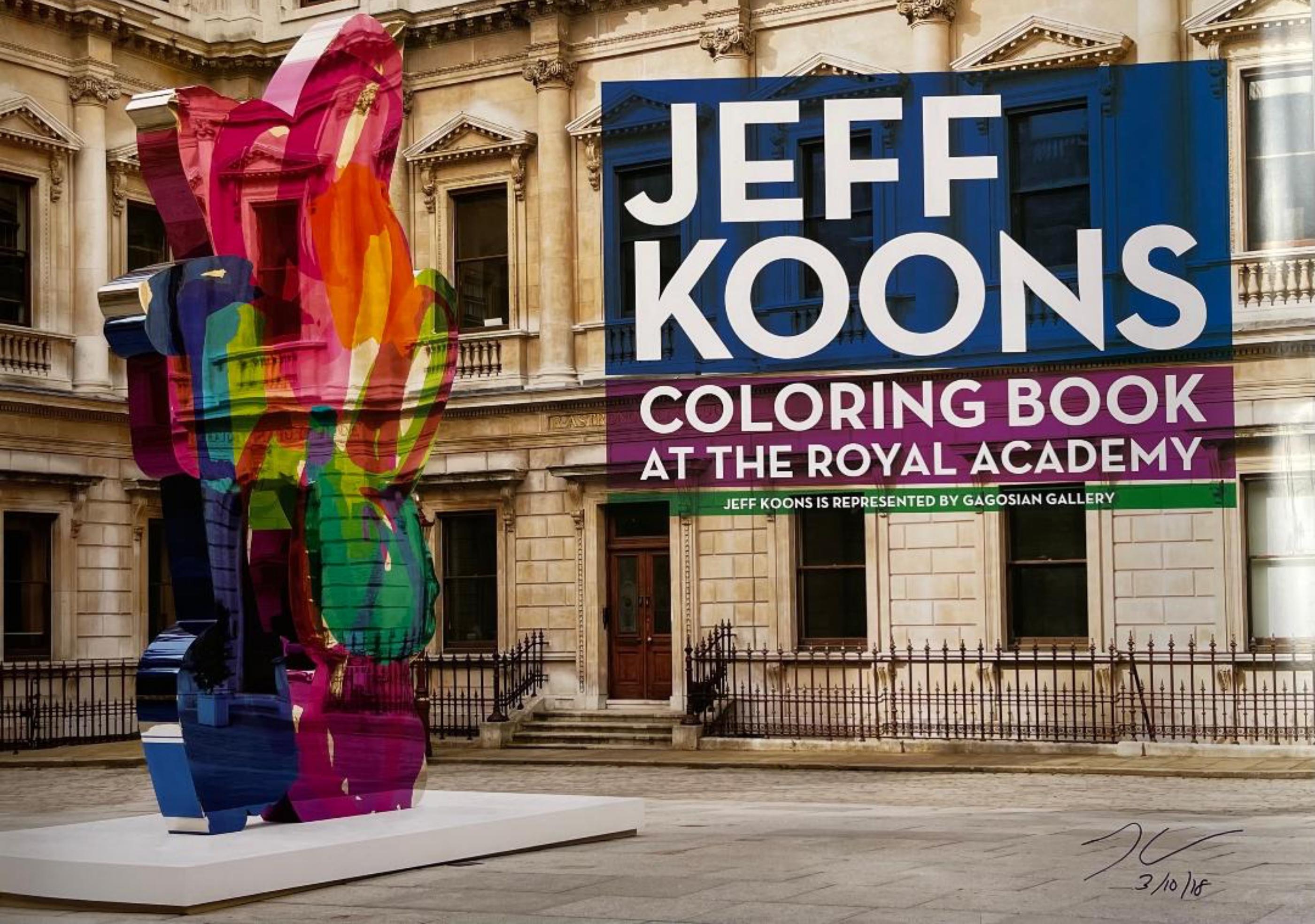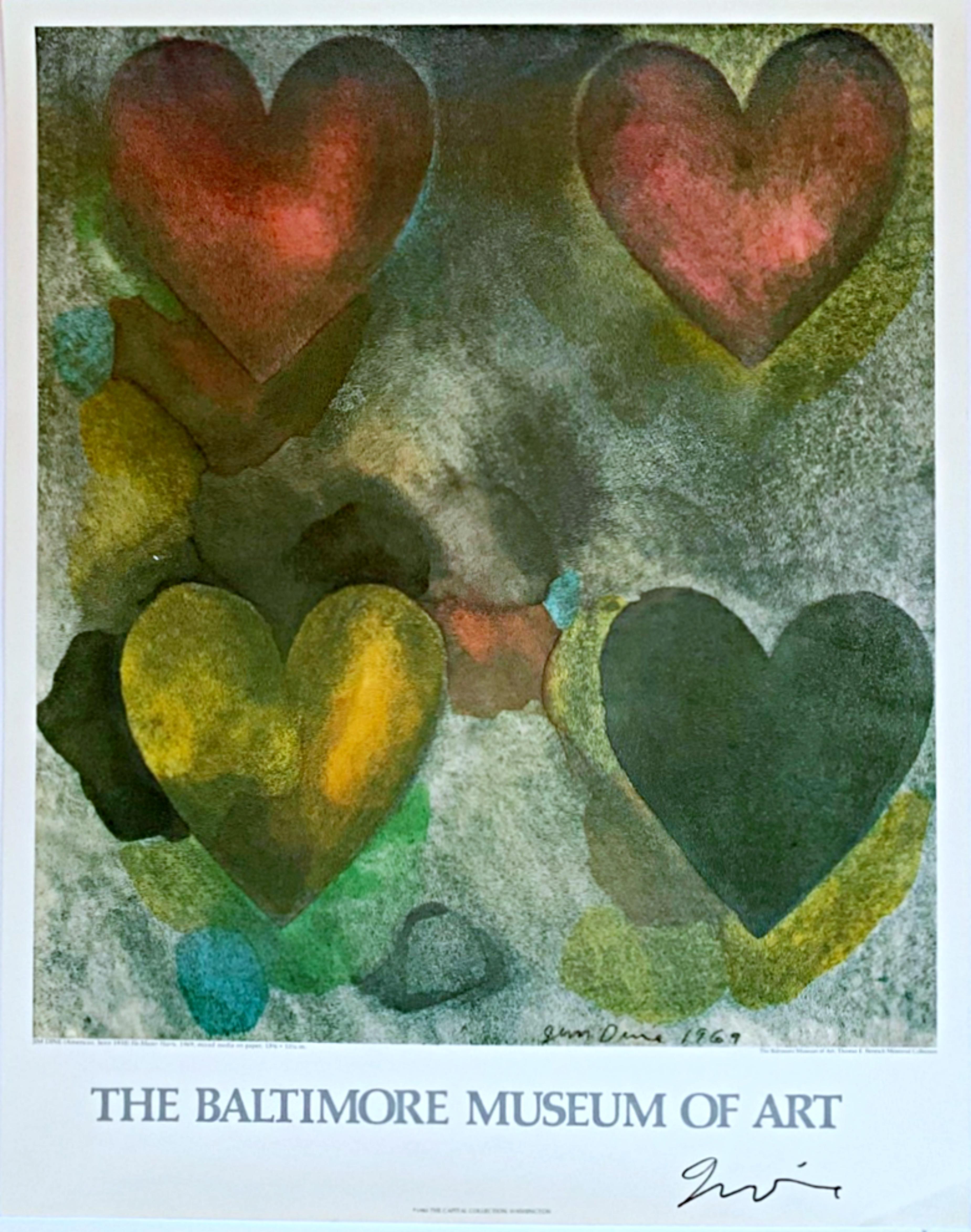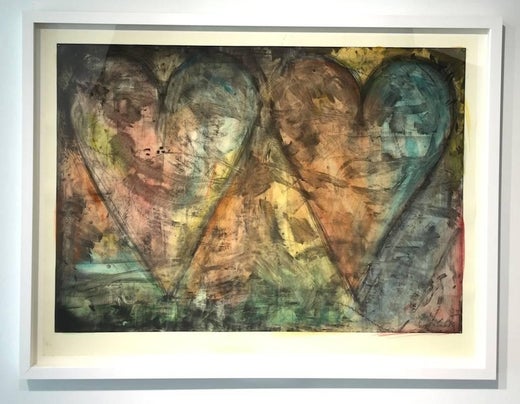Jim DineGilbert & Sullivan Signed and numbered screenprint for the New York City Center1968
1968
About the Item
- Creator:Jim Dine (1935, American)
- Creation Year:1968
- Dimensions:Height: 35 in (88.9 cm)Width: 25 in (63.5 cm)
- Medium:
- Movement & Style:
- Period:
- Condition:
- Gallery Location:New York, NY
- Reference Number:1stDibs: LU1745213953292
Jim Dine
The Ohio-born artist Jim Dine brought his ever-shifting, multidisciplinary vision to New York in 1958, a time of transition in the American art world. Abstract Expressionism, which had dominated the scene for years, was on the wane, and a group of young artists, including Dine, Allan Kaprow, Jasper Johns and Robert Rauschenberg, was eager to replace it with a movement that flipped the traditional rules of art-making on their head.
Beyond dissolving the boundaries between mediums and genres, attaching found objects and detritus to their canvases, these revolutionaries began staging performative “happenings” in public spaces, redefining the very definition of a work of art. As Pop art took form, Dine used objects with personal significance, like his paintbrushes, to transform his paintings into two-dimensional sculptures. He was included in the Norton Simon Museum’s 1962 “New Painting of Objects,” often considered the first true Pop art exhibition in America, but he remained a chameleon, constantly changing his style, material and technique.
More than his contemporaries, Dine has forged new paths in drawing, scrawling words and names across the canvas to create graphic, abstract landscapes. He is obsessed by certain motifs — such as hearts and his own bathrobe — which recur in various forms throughout his oeuvre. He has occasionally worked in classical genres, such as portraiture, as exemplified by the 1980 aquatint Nancy Outside in July. He has also co-opted the bold, graphic vocabulary of advertising and commercials, as in the sleek 2010 composition Gay Laughter at the Wake.
Find Jim Dine prints and other art on 1stDibs.
- ShippingRetrieving quote...Ships From: New York, NY
- Return PolicyA return for this item may be initiated within 1 day of delivery.
- FALCO Dance Co., Aspen Rare rainbow color silkscreen (hand signed & Inscribed)By Robert IndianaLocated in New York, NYRobert Indiana FALCO Dance Company (Hand Signed/Dedicated), 1968 Silkscreen on metallic and wove paper Hand signed by Robert Indiana with personal inscription on the front Unframed T...Category
1960s Pop Art Abstract Prints
MaterialsFoil
- 20th Century Fox (Hand Signed) offset lithograph cardBy Ed RuschaLocated in New York, NYED RUSCHA 20th Century Fox (Hand Signed), 2004 Offset lithograph card. Hand signed in black marker by Ed Ruscha on the front Frame included: Gorgeously framed with different colore...Category
Early 2000s Pop Art Abstract Prints
MaterialsOffset, Permanent Marker, Lithograph
- Jim Dine: Five Themes Limited edition red heart poster (Hand Signed by Jim Dine)By Jim DineLocated in New York, NYJim Dine: Five Themes (Hand Signed), 1985 Offset lithograph. Hand signed by Jim Dine Boldly signed by Jim Dine for the gallery in black marker on the front. 35 × 23 inches Unframed H...Category
1980s Pop Art Figurative Prints
MaterialsLithograph, Offset, Permanent Marker
- Gorgeous Royal Academy of Arts poster print (Hand Signed & dated by Jeff Koons )By Jeff KoonsLocated in New York, NYJEFF KOONS Poster of Jeff Koons Coloring Book at the Royal Academy of Arts, 2011 (Hand Signed), 2018 Offset lithograph 26 1/2 × 36 1/4 inches Boldly hand signed and dated by Jeff Koo...Category
2010s Pop Art Abstract Prints
MaterialsPermanent Marker, Lithograph, Offset
- Rare Hiroshima Peace Celebration signed poster (hand signed by Keith Haring)By Keith HaringLocated in New York, NYKeith Haring Rare Hiroshima Peace Celebration poster (hand signed by Keith Haring), from the Patrick Eddington Collection, 1988 Original offset litho...Category
1980s Pop Art Figurative Prints
MaterialsLithograph, Permanent Marker, Offset
- Four Hearts, rare poster, The Baltimore Museum of Art (Hand Signed by Jim Dine)By Jim DineLocated in New York, NYJim Dine Hearts (Hand Signed), 1983 Offset lithograph 28 × 22 inches Boldly signed in black marker on the front Unframed This vintage hand signed 1983 poster...Category
1980s Pop Art Abstract Prints
MaterialsOffset, Permanent Marker, Lithograph
- Deborah Kass Feminist Jewish American Pop Art Silkscreen Screenprint Ltd EditionBy Deborah KassLocated in Surfside, FLDeborah Kass (born 1952) Limited edition geometric abstract lithograph in colors on artist paper. Hand signed and dated in pencil to lower right. 1973. Edition: 102/120 to lower left. Dimensions: sight: 16-3/4" W x 21-1/4" H. Frame: 24-5/8" W x 28-7/8" H. Finding inspiration in pop culture, political realities, film, Yiddish, art historical styles, and prominent art world figures, Deborah Kass uses appropriation in her work to explore notions of identity, politics, and her own cultural interests. She received her BFA in painting at Carnegie Mellon University and studied at the Whitney Museum Independent Study Program and the Art Students League of New York. Deborah Kass (born 1952) is an American artist whose work explores the intersection of pop culture, art history, and the construction of self. Deborah Kass works in mixed media, and is most recognized for her paintings, prints, photography, sculptures and neon lighting installations. Kass's early work mimics and reworks signature styles of iconic male artists of the 20th century including Frank Stella, Andy Warhol, Jackson Pollock, and Ed Ruscha. Kass's technique of appropriation is a critical commentary on the intersection of social power relations, identity politics, and the historically dominant position of male artists in the art world. Deborah Kass was born in 1952 in San Antonio, Texas. Her grandparents were from Belarus and Ukraine, first generation Jewish immigrants to New York. Kass's parents were from the Bronx and Queens, New York. Her father did two years in the U.S. Air Force on base in San Antonio until the family returned to the suburbs of Long Island, New York, where Kass grew up. Kass’s mother was a substitute teacher at the Rockville Centre public schools and her father was a dentist and amateur jazz musician. At age 14, Kass began taking drawing classes at The Art Students League in New York City which she funded with money she made babysitting. In the afternoons, she would go to theater on and off Broadway, often sneaking for the second act. During her high school years, she would take her time in the city to visit the Museum of Modern Art, where she would be exposed to the works of post-war artists like Frank Stella and Willem De Kooning. At age 17, Stella’s retrospective exhibition inspired Kass to become an artist as she observed and understood the logic in his progression of works and the motivation behind his creative decisions. Kass received her BFA in Painting at Carnegie Mellon University (the alma mater of artist Andy Warhol), and studied at the Whitney Museum Independent Study Program Here, she created her first work of appropriation, Ophelia’s Death After Delacroix, a six by eight foot rendition of a small sketch by the French Romantic artist, Eugène Delacroix. At the same time Neo-Expressionism was being helmed by white men in the late Reagan years, women were just beginning to create a stake in the game for critical works. “The Photo Girls...Category
2010s Pop Art Figurative Prints
MaterialsScreen
- Deborah Kass Feminist Jewish American Pop Art Silkscreen Screenprint Ltd EditionBy Deborah KassLocated in Surfside, FLDeborah Kass (born 1952) Being Alive, 2012 nine-color silkscreen, one color blend on 2-ply museum board Image 24 x 24 image. Frame 29 x 29 x 2 inches Edition 1/65 Hand signed and dated in pencil, lower right verso; numbered lower left verso Being Alive is from a vibrant and uplifting body of work entitled Feel Good Paintings for Feel Bad Times. Finding inspiration in pop culture, political realities, film, Yiddish, art historical styles, and prominent art world figures, Deborah Kass uses appropriation in her work to explore notions of identity, politics, and her own cultural interests. She received her BFA in painting at Carnegie Mellon University and studied at the Whitney Museum Independent Study Program and the Art Students League of New York. Deborah Kass (born 1952) is an American artist whose work explores the intersection of pop culture, art history, and the construction of self. Deborah Kass works in mixed media, and is most recognized for her paintings, prints, photography, sculptures and neon lighting installations. Kass's early work mimics and reworks signature styles of iconic male artists of the 20th century including Frank Stella, Andy Warhol, Jackson Pollock, and Ed Ruscha. Kass's technique of appropriation is a critical commentary on the intersection of social power relations, identity politics, and the historically dominant position of male artists in the art world. Deborah Kass was born in 1952 in San Antonio, Texas. Her grandparents were from Belarus and Ukraine, first generation Jewish immigrants to New York. Kass's parents were from the Bronx and Queens, New York. Her father did two years in the U.S. Air Force on base in San Antonio until the family returned to the suburbs of Long Island, New York, where Kass grew up. Kass’s mother was a substitute teacher at the Rockville Centre public schools and her father was a dentist and amateur jazz musician. At age 14, Kass began taking drawing classes at The Art Students League in New York City which she funded with money she made babysitting. In the afternoons, she would go to theater on and off Broadway, often sneaking for the second act. During her high school years, she would take her time in the city to visit the Museum of Modern Art, where she would be exposed to the works of post-war artists like Frank Stella and Willem De Kooning. At age 17, Stella’s retrospective exhibition inspired Kass to become an artist as she observed and understood the logic in his progression of works and the motivation behind his creative decisions. Kass received her BFA in Painting at Carnegie Mellon University (the alma mater of artist Andy Warhol), and studied at the Whitney Museum Independent Study Program Here, she created her first work of appropriation, Ophelia’s Death After Delacroix, a six by eight foot rendition of a small sketch by the French Romantic artist, Eugène Delacroix. At the same time Neo-Expressionism was being helmed by white men in the late Reagan years, women were just beginning to create a stake in the game for critical works. “The Photo Girls” consisted of artists like Sherrie Levine, Cindy Sherman, and Barbara Kruger. Kass felt that content of these works connected those of the post-war abstract painters of the mid-70s including Elizabeth Murray, Pat Steir, and Susan Rothenberg. All of these artists critically explored art in terms of new subjectivities from their points-of-view as women. Kass took from these artists the ideas of cultural and media critique, inspiring her Art History Paintings. Kass is most famous for her “Decade of Warhol,” in which she appropriated various works by the pop artist, Andy Warhol. She used Warhol’s visual language to comment on the absence of women in art history at the same time that Women’s Studies began to emerge in academia. Reading texts on subjectivity, objectivity, specificity, and gender fluidity by theorists like Judith Butler and Eve Sedgwick, Kass became literate in ideas surrounding identity. She engaged with art history through the lens of feminism, because of this theory which “The Photo Girls” drew upon. Kass's work is in the collections of the Museum of Modern Art; Whitney Museum of American Art; Solomon R. Guggenheim Museum; Jewish Museum (New York); Museum of Fine Art, Boston; Cincinnati Museum of Art; New Orleans Museum; National Portrait Gallery, Smithsonian Institution; Fogg Museum, Harvard Art Museums; and Weatherspoon Museum, among others. In 2012 Kass's work was the subject of a mid-career retrospective Deborah Kass, Before and Happily Ever After at The Andy Warhol Museum in Pittsburgh, PA. An accompanying catalogue published by Skira Rizzoli, included essays by noted art historians Griselda Pollock, Irving Sandler, Robert Storr, Eric C. Shiner and writers and filmmakers Lisa Liebmann, Brooks Adams, and John Waters. Kass's work has been shown at international private and public venues including at the Venice Biennale, the Istanbul Biennale, the Museum Ludwig, Cologne, the Museum of Modern Art, The Jewish Museum, New York, the National Portrait Gallery, and the Museum of Fine Arts, Boston. A survey show, Deborah Kass, The Warhol Project traveled across the country from 1999–2001. She is a Senior Critic in the Yale University M.F.A. Painting Program. Kass's later paintings often borrow their titles from song lyrics. Her series feel good paintings for feel bad times, incorporates lyrics borrowed from The Great American Songbook, which address history, power, and gender relations that resonate with Kass's themes in her own work. In Kass's first significant body of work, the Art History Paintings, she combined frames lifted from Disney cartoons with slices of painting from Pablo Picasso, Jasper Johns, Jackson Pollock, and other contemporary sources. Establishing appropriation as her primary mode of working, these early paintings also introduced many of the central concerns of her work to the present. Before and Happily Ever After, for example, coupled Andy Warhol’s painting of an advertisement for a nose job with a movie still of Cinderella fitting her foot into her glass slipper, touching on notions of Americanism and identity in popular culture. The Art History Paintings series engages critically with the history of politics and art making, especially exploring the power relationship of men and women in society. Deborah Kass's work reveals a personal relationship she shares with particular artworks, songs and personalities, many of which are referenced directly in her paintings. In 1992, Kass began The Warhol Project. Beginning in the 1960s, Andy Warhol’s paintings employed mass production through screen-printing to depict iconic American products and celebrities. Using Warhol’s stylistic language to represent significant women in art, Kass turned Warhol’s relationship to popular culture on its head by replacing them with subjects of her own cultural interests. She painted artists and art historians that were her heroes including Cindy Sherman, Elizabeth Murray, and Linda Nochlin. Drawing upon her childhood nostalgia, the Jewish Jackie series depicts actress Barbra Streisand, a celebrity with whom she closely identifies, replacing Warhol's prints of Jackie Kennedy Onassis and Marilyn Monroe. Her My Elvis series likewise speaks to gender and ethnic identity by replacing Warhol's Elvis with Barbra Streisand from Yentl: a 1983 film in which Streisand plays a Jewish woman who dresses and lives as a man in order to receive an education in the Talmudic Law. Kass's Self Portraits as Warhol further deteriorates the idea of rigid gender norms and increasingly identifies the artist with Warhol. By appropriating Andy Warhol's print Triple Elvis and replacing Elvis Presley with Barbara Streisand’s Yentl, Kass is able to identify herself with history’s icons, creating a history with powerful women as subjects of art. The work embodies her concerns surrounding gender representation, advocates for a feminist revision of art, and directly challenges the tradition of patriarchy. America's Most Wanted is a series of enlarged black-and-white screen prints of fake police mug shots. The collection of prints from 1998–1999 is a late-1990s update of Andy Warhol’s 1964 work 13 Most Wanted Men, which featured the most wanted criminals of 1962. The “criminals” are identified in titles only by first name and surname initial, but in reality the criminals depicted are individuals prominent in today's art world. Some of the individuals depicted include Donna De Salvo, deputy director for international initiatives and senior curator at the Whitney Museum of American Art; Thelma Golden, director and chief curator of the Studio Museum in Harlem, and Robert Storr, dean of the Yale School of Art. Kass's subjects weren’t criminals. Through this interpretation, Kass show's how they are wanted by aspirants for their ability to elevate artists’ careers. The series explores the themes of authorship and the gaze, at the same time problematizing certain connotations within the art world. In 2002, Kass began a new body of work, feel good paintings for feel bad times, inspired, in part, by her reaction to the Bush administration. These works combine stylistic devices from a wide variety of post-war painting, including Ellsworth Kelly, Frank Stella, Jackson Pollock, Andy Warhol, and Ed Ruscha, along with lyrics by Stephen Sondheim, Laura Nyro, and Sylvester, among others, pulling from popular music, Broadway show tunes, the Great American Songbook, Yiddish, and film. The paintings view American art and culture of the last century through the lens of that time period's outpouring of creativity that was the result of post-war optimism, a burgeoning middle class, and democratic values. Responding to the uncertain political and ecological climate of the new century in which they have been made, Kass's work looks back on the 20th century critically and simultaneously with great nostalgia, throwing the present into high relief. Drawing, as always, from the divergent realms of art history, popular culture, political realities, and her own political and philosophical reflection, the artist continues into the present the explorations that have characterized her paintings since the 1980s in these new hybrid textual and visual works. OY/YO In 2015, Two Tree Management Art in Dumbo commissioned of a monumentally scaled installation of OY/YO for the Brooklyn Bridge Park. The sculpture, measuring 8×17×5 ft., consists of big yellow aluminum letters, was installed on the waterfront and was visible from the Manhattan. It spells “YO” against the backdrop of Brooklyn. The flip side, for those gazing at Manhattan, reads “OY.”[ An article and photo appeared on the front page of the New York Times 3 days after its installation in the park. An instant icon, OY/YO stayed at that site for 10 months where it became a tourist destination, a favorite spot for wedding, graduation, class photos and countless selfies. After its stay in Dumbo it moved to the ferry stop at North 6th Street in Williamsburg, Brooklyn for a year, where it greeted ferry riders. Since 2011, OY/YO has been a reoccurring motif in Deborah Kass's work in the form of paintings, prints, and tabletop sculptures. Kass first created “OY” as a painting riffing on Edward Ruscha’s 1962 Pop canvas, “OOF.” She later painted “YO” as a diptych that nodded to Picasso's 1901 self-portrait, “Yo Picasso” (“I, Picasso”). OY/YO is now installed in front of the Brooklyn Museum. Another arrived at Stanford University in front of the Cantor Arts Center late 2019. A large edition of OY/YO was acquired by the Jewish Museum in New York in 2017 and is on view in the exhibition Scenes from the Collection. On December 9, 2015 Deborah Kass introduced her new paintings that incorporated neon lights in an exhibition at Paul Kasmin Gallery entitled "No Kidding" in Chelsea, New York. The exhibition was an extension of her Feel Good Paintings for Feel Bad Times, but it sets a darker, tougher tone as she reflects on contemporary issues such as global warming, institutional racism, political brutality, gun violence, and attacks on women's health, through the lens of minimalism and grief. The series is ongoing. Deborah Kass has spoken about creating an “ode to the great Louises,” a space dedicated to her works inspired by famous Louise’s which she would call the “Louise Suite.” The earliest of these odes is “Sing Out Louise,” a 2002 oil on linen painting from her Feel Good Paintings Feel Bad Times collection. “Sing out Louise” is driven by her fondness for Rosalind Russel and the fact Kass feels it is her time to “Sing Out] “After Louise Bourgeois” is a 2010 sculpture made of neon and transformers on powder-coated aluminum monolith; it is a spiraling neon light with a phrase inspired by French-American artist Louise Bourgeois.[22] The neon installation reads “A woman has no place in the art world unless she proves over and over again that she won’t be eliminated.” Kass changed the quote slightly to better represent her beliefs but it was derived from Bourgeois. “After Louise Nevelson” is a 2020 spiraling neon work of art that reads "Anger? I'd be dead without my anger" a quote from American sculptor, Louise Nevelson. Award and Grants New York Foundation for the Arts, inducted into NYFA Hall of Fame (2014) Art Matters Inc. Grant (1996) Art Matters Inc. Grant (1992) New York Foundation for the Arts, Fellowship in Painting 1987 National Endowment for the Arts, Painting (1991) National Endowment For The Arts (1987) Selected solo and group exhibitions The Jewish Museum, New York, NY, “Scenes from the Collection” National Portrait Gallery, Washington, DC “Eye Pop: the Celebrity Gaze” Paul Kasmin Gallery, New York, NY, “No Kidding” (2015-2016) Sargent...Category
2010s Pop Art Figurative Prints
MaterialsScreen
- Large Pop Art Abstract Figure Digital Barcode Silkscreen Screenprint 80s MemphisBy David PrenticeLocated in Surfside, FLI was told this might be by another David Prentice. as I am uncertain I will add his bio. I cannot ascertain which one it is. Vintage 1981 DAVID PRENTI...Category
1980s Pop Art Figurative Prints
MaterialsScreen
- Vibrant Joe Tilson British Pop Art Screenprint, Woodblock, Colorful PrintBy Joe TilsonLocated in Surfside, FLSilkscreen screenprint with woodblock and silver leaf Hand signed and numbered. In vibrant color of blue and silver on heavy paper with an almost painting type texture to it. Josep...Category
1990s Pop Art Abstract Prints
MaterialsScreen
- Joe Tilson British Pop Art Screenprint, Woodblock, Gold Leaf PrintBy Joe TilsonLocated in Surfside, FLSilkscreen screenprint with woodblock and gold leaf Hand signed and numbered. Joseph Charles Tilson RA (born 24 August 1928 in London) is an English pop art painter, sculptor and pr...Category
1990s Pop Art Abstract Prints
MaterialsScreen
- Joe Tilson British Pop Art Screenprint, Color Lithograph 4 Seasons 4 ElementsBy Joe TilsonLocated in Surfside, FLSilkscreen screenprint or Lithograph Hand signed and numbered. An esoteric, mystical, Kabbala inspired print with Hebrew as well as other languages. Joseph Charles Tilson RA (born 2...Category
1970s Pop Art Abstract Prints
MaterialsLithograph, Screen
